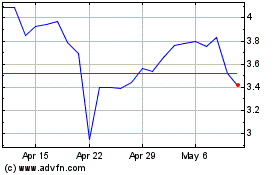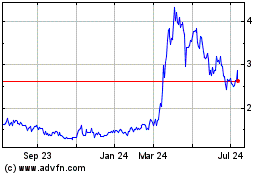ChromaDex Corp. (NASDAQ:CDXC), an innovator of proprietary health,
wellness and nutritional ingredients that creates science-based
solutions for dietary supplement, food and beverage, skin care,
sports nutrition, and pharmaceutical products, announced today that
results from three studies, including its first human clinical
trial, have been collectively published in the prestigious journal,
Nature Communications.
The team of researchers headed by Charles Brenner, PhD, the Roy
J. Carver Chair of Biochemistry at the University of Iowa Carver
College of Medicine, demonstrated that NIAGEN® nicotinamide
riboside (NR) increases production of a metabolite responsible for
cellular energy production called NAD+ in mice and humans. These
findings may give us a clue as to how we might help ourselves enjoy
longer and healthier lives.
NAD+ activates cellular metabolism and energy production within
the “powerhouses of the cell”, the mitochondria. Our mitochondria
are constantly working to convert calories from food into the
energy necessary to power all bodily systems, as well as help us
stay healthy enough to ward off illness. This is why NAD+ needs to
continuously be replenished in the body. The challenge is that both
NAD+ levels and mitochondrial function decline as we age. This
reduction in NAD+ is believed by scientists to be linked to a wide
variety of age-related conditions.
NR boosts NAD+ production and utilization better than
other forms of vitamin B3
The benefits of NR remained unknown for years after its initial
identification in the 1940’s because scientists did not realize
there was a way for it to boost NAD+ levels in humans. In 2004,
then a faculty member at Dartmouth, Brenner discovered the enzymes
in humans that enable NR to increase NAD+ and identified it as a
vitamin. This discovery also suggested that NR had the ability to
boost NAD+ in a safe and more efficient way than can be achieved
with its B3 cousins, niacin or nicotinamide, giving the body
extra energy to focus on its critical needs. Despite more than 75
years of human use of niacin and more than a decade of preclinical
work on NR, a quantitative head-to-head-to-head comparison of the
three NAD+ precursor vitamins had never been conducted to validate
this hypothesis.
In this latest published research, Brenner and his team – along
with collaborators at Queens University Belfast and ChromaDex –
demonstrated that NR is not only effective at safely increasing
NAD+ metabolism in people but also showed that NR produces a
greater increase in liver NAD+ as well as in longevity-promoting
sirtuin activities than the other B3 vitamins in mice. “We obtained
convincing evidence that oral supplementation of NR boosts NAD+ and
enhances the body’s utilization of NAD+ to a greater degree than
the familiar forms of vitamin B3. NR is the most efficient NAD+
precursor,” Brenner shared.
Further hypotheses were validated in his study of 12 healthy men
and women who were given three doses of NR: 100 mg, 300 mg and 1000
mg. The results indicated that 24 hours after taking any single
dose of NR, blood NAD+ was safely elevated.
According to ChromaDex’s Founder and CEO, Frank Jaksch, “These
results are highly significant because the degree of NAD+ boosting
with reported health benefits in mice has been translated in people
with an orally supplemented NR. This validates NR as the most
efficient NAD+ precursor, and one that does not cause flushing or
inhibit the activity of sirtuins.”
Asked about his thoughts on the research results, Jaksch
commented, “Dr. Brenner is the world’s leading expert on NAD+
metabolism, which is why we felt he needed to lead this research
and serve on our Scientific Advisory Board. His innovative work is
what started the tremendous interest in NR and NAD+
precursors. This is yet another valuable contribution from
Dr. Brenner’s lab which pushes the NR and NAD+ fields of study
forward. We expect to see additional published findings from his
group in the near future.”
Unexpected findings that excite the experts
A distinct strength of the Brenner group is the development of
targeted quantitative metabolomic technologies – the simultaneous
measurement of the effects of NR, exercise or other interventions
on metabolism. In the first of his three studies Brenner was
surprised to find that a low level metabolite called NAAD increased
45-fold as human NAD+ rose in response to NR. This increase
signaled that NAAD could be a biomarker of increased NAD+
formation. His second study confirmed this hypothesis while also
demonstrating that NAAD is formed from NR. Following NAAD showed
that even tissues such as the heart that keep tight control over
the total amount of NAD+ have an increase in NAD+ metabolism when
NR is supplemented. “NAAD is a reliable biomarker of increased NAD+
metabolism,” explains Brenner. “The more NAD+ produced, the more we
see the NAAD biomarker.”
By following an additional metabolite that is produced when the
sirtuin longevity proteins utilize NAD+, Brenner demonstrated that
NR has great advantages over niacin and nicotinamide in activating
these proteins in the body. This finding is significant, as many
scientists believe sirtuin activation plays an important role in
living longer and healthier throughout our lifetime.
What this means in terms of our health and
energy
Though larger increases in NAD+ metabolism were observed at
higher doses, the study was significant in showing that lower doses
were also effective. Daily NR supplementation – now widely
available – safely helps to replenish NAD+ levels. “Maintaining a
more youthful metabolism could mean higher resting metabolic rate,
resistance to weight gain, and the ability to maintain muscle mass
and resist tissue damage over time,” adds Brenner. Results from 9
additional collaborative human trials currently underway should
provide additional insights as to the critical role NAD+ plays in
people. For additional information about NIAGEN®, visit
www.Chromadex.com.
About ChromaDex: ChromaDex leverages its
complementary business units to discover, acquire, develop and
commercialize patented and proprietary ingredient technologies that
address the dietary supplement, food, beverage, skin care and
pharmaceutical markets. In addition to our ingredient technologies
unit, we also have business units focused on natural product fine
chemicals (known as "phytochemicals"), chemistry and analytical
testing services, and product regulatory and safety consulting
(known as Spherix Consulting). As a result of our relationships
with leading universities and research institutions, we are able to
discover and license early stage, IP-backed ingredient
technologies. We then utilize our in-house chemistry, regulatory
and safety consulting business units to develop commercially viable
ingredients. Our ingredient portfolio is backed with clinical and
scientific research, as well as extensive IP protection. Our
portfolio of patented ingredient technologies includes NIAGEN®
nicotinamide riboside; pTeroPure® pterostilbene; PURENERGY®, a
caffeine-pTeroPure® co-crystal; IMMULINA™, a spirulina extract; and
AnthOrigin™, anthocyanins derived from a domestically-produced,
water-extracted purple corn. To learn more about ChromaDex, please
visit www.ChromaDex.com.
Forward-Looking Statements:
This release contains forward-looking statements
within the meaning of Section 27A of the Securities Act of
1933, as amended, and Section 21E of the Securities and
Exchange Act of 1934, as amended, including statements related to
results of the NIAGEN® studies and their significance. Statements
that are not a description of historical facts constitute
forward-looking statements and may often, but not always, be
identified by the use of such words as "expects", "anticipates",
"intends", "estimates", "plans", "potential", "possible",
"probable", "believes", "seeks", "may", "will", "should", "could"
or the negative of such terms or other similar expressions. More
detailed information about ChromaDex and the risk factors that may
affect the realization of forward-looking statements is set forth
in ChromaDex's Annual Report on Form 10-K for the fiscal year ended
January 2, 2016, ChromaDex's Quarterly Reports on Form 10-Q and
other filings submitted by ChromaDex to the SEC, copies of which
may be obtained from the SEC's website at www.sec.gov. Readers are
cautioned not to place undue reliance on these forward-looking
statements, which speak only as of the date hereof, and actual
results may differ materially from those suggested by these
forward-looking statements. All forward-looking statements are
qualified in their entirety by this cautionary statement and
ChromaDex undertakes no obligation to revise or update this release
to reflect events or circumstances after the date hereof. ChromaDex
provided research materials and a portion of the grant funding as a
collaborator for the study. ChromaDex’s Founder and CEO, Frank
Jaksch is a named author on the study. Charles Brenner serves on
the scientific advisory board at ChromaDex. He is also co-founder
and Chief Scientific Adviser of ProHealthspan.
ChromaDex Public Relations Contact:
Breah Ostendorf, Director of Marketing
949-537-4103
breaho@chromadex.com
ChromaDex Investor Relations Contact:
Andrew Johnson, Director of Investor Relations
949-419-0288
andrewj@chromadex.com
ChromaDex (NASDAQ:CDXC)
Historical Stock Chart
From Mar 2024 to Apr 2024

ChromaDex (NASDAQ:CDXC)
Historical Stock Chart
From Apr 2023 to Apr 2024
